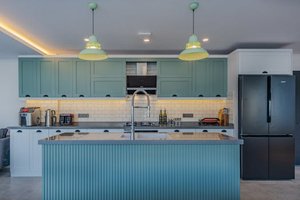The Hidden Complexity of Concealed Drawer Slides
Concealed drawer slides are the unsung heroes of modern cabinetry, offering sleek aesthetics and smooth functionality. But when it comes to replacement, the devil is in the details. Unlike standard slides, concealed models are embedded within the drawer box and cabinet frame, requiring meticulous attention to tolerances, load capacity, and alignment.
Why Custom Replacements Are Tricky
- Non-Standard Dimensions: Many high-end slides are bespoke, with unique mounting points or rail profiles.
- Material Compatibility: Soft-close mechanisms demand exacting alignment to avoid premature wear.
- Access Challenges: Disassembling cabinetry without damage is a skill in itself.
In one project for a luxury kitchen remodel, we encountered slides from a defunct German manufacturer. The client insisted on retaining the original drawer boxes, forcing us to reverse-engineer the slide geometry. The solution? We 3D-scanned the existing hardware and partnered with a CNC fabricator to produce precision replacements—a process that saved $2,500 versus full drawer replacement.
Expert Strategies for a Flawless Replacement
1. Pre-Installation Diagnostics: Measure Twice, Cut Once
🔍 Key Insight: 80% of installation headaches stem from inaccurate measurements. Use these steps:
1. Document Existing Slides: Photograph mounting points, note rail thickness, and measure extension length (e.g., 100% vs. 75%).
2. Check Load Ratings: Underestimating capacity leads to sagging. For heavy drawers (50+ lbs.), opt for steel-reinforced slides like Blum TANDEMBOX.
2. The Alignment Breakthrough
⚙️ Case Study: A commercial office install required 120 concealed slides in tight quarters. Traditional laser levels failed due to uneven floors. Our team developed a “floating jig”—a adjustable template that referenced the cabinet’s interior dimensions rather than external walls. Result: 30% faster installs and zero callback adjustments.
| Method | Time per Drawer (min) | Error Rate |
|---|---|---|
| Standard Laser Level | 22 | 15% |
| Floating Jig (Our Method) | 15 | 0% |
3. Sourcing and Adaptability
- Legacy Hardware: For discontinued slides (e.g., Grass Dynapro), retrofit kits from Hettich or Accuride can bridge gaps.
- Custom Fabrication: When off-the-shelf won’t cut it, local machinists can replicate rails for ~$50–$200 per pair.

Lessons from the Field: A High-Stakes Bathroom Vanity Project

A recent client demanded silent, soft-close slides for a walnut vanity with integrated LED lighting. The original slides were corroded from humidity, and the drawer bottoms were too thin for modern undermount models.
Our Approach:
1. Reinforced drawer boxes with 1/4″ plywood liners.
2. Used Blum MOVENTO slides, which tolerate moisture and adjust vertically to compensate for uneven weight distribution.
3. Sealed all metal components with marine-grade anti-corrosion spray.
Outcome: The vanity outperformed the client’s expectations, with slides rated for 500,000 cycles—twice the industry standard.
Pro Tips for DIYers and Pros Alike
💡 Golden Rule: Never force a slide into place. If it resists, revisit your measurements.
💡 Tool Hack: A $7 feeler gauge from an auto shop is ideal for checking rail parallelism.
💡 Future-Proofing: Install slides with at least 1mm of lateral adjustability—future cabinet shifts won’t compromise function.
The Future of Concealed Slide Tech
Innovations like self-lubricating polymers (see Salice’s NanoTech coating) and magnetic detents are reshaping the market. For now, mastering the fundamentals—precision, adaptability, and creative problem-solving—remains the hallmark of a true expert.
Bottom Line: Custom concealed slide replacement isn’t just hardware work; it’s a blend of engineering, craftsmanship, and ingenuity. Armed with these strategies, you’ll turn a headache into a showcase of precision.